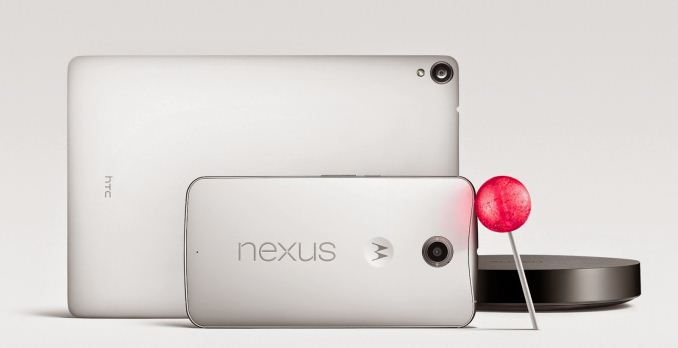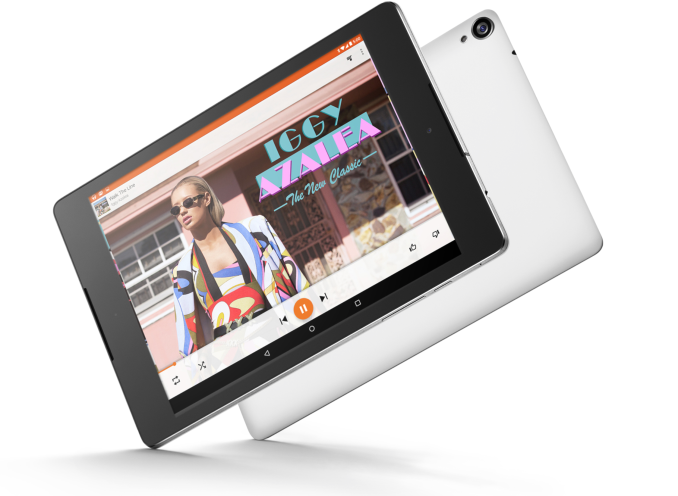Google Announces the Nexus 6 and Nexus 9 Running Android Lollipop
by Brandon Chester on October 15, 2014 12:33 PM EST
Today Google has officially announced the newest devices in the Nexus line, just one day before Apple's October event. Both devices have been rumored for some time now, and this is the first time in a while that we've seen Google introduce a new smartphone and tablet at the same time. The first device in the announcement is the Nexus 6, made by Motorola. The second is the Nexus 9 tablet made by HTC. To give an overview of how both devices look on paper, I've put together their specifications in a chart below.
| Nexus 6 | Nexus 9 | |
| SoC | 2.7GHz Snapdragon 805 (APQ8084) with 4 x Krait 450 + Adreno 420 at 600MHz | 2.3GHz 64-bit dual core Tegra K1 Denver SoC |
| RAM/NAND | 3GB LPDDR3 + 32/64GB NAND | 2GB LPDDR3 + 16/32GB NAND |
| Display | 5.96" 2560x1440 AMOLED | 8.9" 2048x1536 IPS LCD |
| Network | 2G / 3G / 4G LTE | WiFi only or 2G / 3G / 4G LTE SKU |
| Dimensions | 82.98 x 159.26 x 10.06mm, 184g | 153.68 x 228.25 x 7.95mm, 425g WiFi, 436g LTE |
| Camera | 13MP Rear Facing with F/2.0 aperture and OIS, 2MP FFC 4K video recording |
8MP Rear Facing with F/2.4 aperture, 1.6MP FFC |
| Battery | 3220 mAh (12.236 Whr) | 6700 mAh (25.46 Whr) |
| OS | Android 5.0 Lollipop | Android 5.0 Lollipop |
| Connectivity | 802.11a/b/g/n/ac + BT 4.1, USB2.0, GPS/GNSS, NFC | 802.11a/b/g/n/ac + BT 4.1, USB2.0, GPS/GNSS, NFC |
| SIM Size | NanoSIM | NanoSIM on LTE SKU |
 The Nexus 6 features a similar appearance to Motorola's other devices like the Moto X and Moto G. The plastic back is surrounded by a contoured aluminum frame that curves downward at the top where the 3.5mm headphone jack is located. On the back is Google's traditional Nexus logo, accompanied by an indented motorola logo and a centered rear-facing camera. The front is dominated by a large 5.96" display with a pixel density of 493ppi, and stereo speakers on the top and bottom bezels.
The Nexus 6 features a similar appearance to Motorola's other devices like the Moto X and Moto G. The plastic back is surrounded by a contoured aluminum frame that curves downward at the top where the 3.5mm headphone jack is located. On the back is Google's traditional Nexus logo, accompanied by an indented motorola logo and a centered rear-facing camera. The front is dominated by a large 5.96" display with a pixel density of 493ppi, and stereo speakers on the top and bottom bezels.
In terms of its specifications, the Nexus 6 is competitive with all the current Android flagship devices. It packs Qualcomm's latest silicon, a hefty battery, and a high resolution display. However, those premium specs are accompanied by a premium price of $649 outright which is significantly more than the $349 that the Nexus 5 is priced at. The Nexus 5 has been given a new web page along with the other Nexus devices which suggests it isn't going disappear with the launch of this newer, more expensive smartphone.
The next announcement was the Nexus 9 made by HTC. This is the first tablet from HTC since the days of Android Gingerbread and Honeycomb where HTC announced they were exiting the tablet market. With its soft touch back, the Nexus 9 is similar in its design to the Nexus 5. Unlike the Nexus 5 which was an entirely plastic construction, the sides of the Nexus 9 are made of brushed metal.
The front of the device is similar to the Nexus 7 with its asymmetrical bezels. The shape of the device is a departure from any tablet Google has produced before, with a 2048x1536 4:3 display like Apple's iPad. Both the 8.9" display size and 4:3 aspect ratio make the Nexus 9 a significantly larger device than the Nexus 7.
The SoC is the biggest point of interest with the Nexus 9. It will be the first device to ship with Nvidia's Project Denver architecture. This is a custom 64-bit ARMv8 architecture designed by Nvidia, a significant departure from the standard ARM cores used in previous Tegra chips. We covered the details about Tegra K1 Denver previously and you can read that over to get a more in-depth look at NVIDIA's new chip.
Along with the new device announcements comes the official name for the next version of Android. Android L is now Android 5.0 Lollipop, and it will ship on the new Nexus 6 and Nexus 9. Lollipop comes with Google's new Material Design and Google's new ART runtime, and will be rolling out to existing compatible Nexus and Google Play Edition devices in the coming weeks.
The Nexus 9 will be available for pre-order on October 17th starting at $399 for 16GB, while the Nexus 6 will be available sometime in late October at $649 for 32GB.
Source: Google Blog











148 Comments
View All Comments
Spectrophobic - Wednesday, October 15, 2014 - link
Let's be honest here... For most people, Android is generally not a productivity platform. A lot of people use it for media consumption, mostly videos. Most videos people consume are 16:9 or wider. Unless I'm unaware of a special liking towards black bars, 4:3 (and 16:10, but it's tolerable on <10") is a no-no.madwolfa - Thursday, October 16, 2014 - link
I only watch videos on my tablet maybe 10-20% of the time.Spectrophobic - Thursday, October 16, 2014 - link
I did say "most" not "all". I'm aware there are people who use Android/iOS tablets for browsing and staring at documents/spreadsheets 90% of the time. In those scenarios, 4:3 would be good. 16:10 would still be ideal as it is the closest to being the jack of all trade on <10" screens, in my humble opinion.gamer1000k - Wednesday, October 15, 2014 - link
Looking at the price and specs of the Nexus 9 makes me very glad I went ahead and got the Shield Tablet instead. For the same price as the 16gb entry level Nexus 9 (Anandtech, you really need to get on the case of these device manufacturers and shame them into starting at 32gb and offering higher capacity models) you can get the 32gb Shield Tablet with LTE. The microsd card slot and pen are a bonus, not sure why anyone would buy the Nexus 9 when nvidia has a better product (IMHO) at a better price.Bob Todd - Wednesday, October 15, 2014 - link
I assumed I'd sell my wife's iPad 3 for a Nexus 9, but now what I really want is a Shield tablet revision with Denver cores. I hope they release one before Christmas.TheJian - Thursday, October 16, 2014 - link
I'll maybe bite at 20nm version of Nv's chip (K1 or M1 doesn't really matter, I want the shrink). That should allow amped up power, battery or a combo of better by some margin on both sides. This close to a shrink I'm out, no matter how good something looks. Screw xmas, I can wait this out for a MUCH better device at 20nm.I hope they do a larger tablet (NV I mean). Why not compete with more sizes? I'd like to see a 20nm 13in ;) I've never really been impressed with my dads 10in nexus. Too small to watch my training vids, and browsing isn't much better. I want a 13in with NV inside. I could be sold on a R2 shield handheld at 20nm also, but we'll see :) I may just wait until June/July for 20nm M1 (earlier maybe?). Maxwell drops the power so much over Kepler it's hard to not just sit on my hands for a while...LOL A die shrink+what we already see maxwell doing on 28nm desktops would surely be impressive for an android gamer's future ;)
TheJian - Thursday, October 16, 2014 - link
Agreed...Shame on google for these specs for their tablet at this price range.Laststop311 - Wednesday, October 15, 2014 - link
The nexus 6 looks really awesome. I was going to get the galaxy note 4 as I currently have a galaxy note 2 and the note 4 has LTE band 12 support which is needed for t-mobiles new 700mhz spectrum. If the nexus 6 supports LTE band 12 I think I will switch to it instead. 32GB note 4 is 750 and this nexus 6 32GB is 650 the 64GB should be 729 so with the nexus 6 I can get double the space and cheaper price but where can I find the frequencies it supports?Laststop311 - Wednesday, October 15, 2014 - link
awesome I found it LTE band 12 IS supported on the nexus 6. Looks like nexus 6 will be my next device. Shame on the price but you pay for quality.TheJian - Wednesday, October 15, 2014 - link
Someone explain to me why the phone has more mem/storage than the tablet? I'm not saying I don't like the phone's specs, but the tablet? I expect at least the same and from a device this late in 2014 I expect 3GB or more now at this range, PERIOD. You block the SD slot from your devices too, so at minimum I expect a 64GB storage option on ANY google device, PERIOD. Sorry google, you lost me at HELLO. LOL.